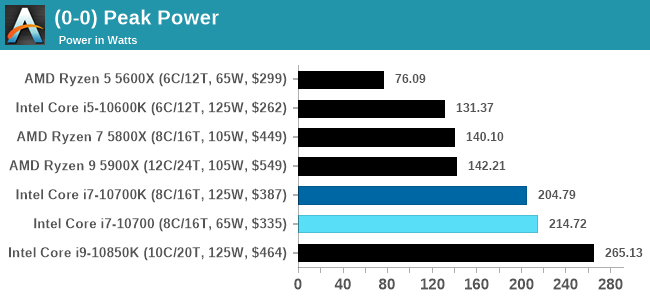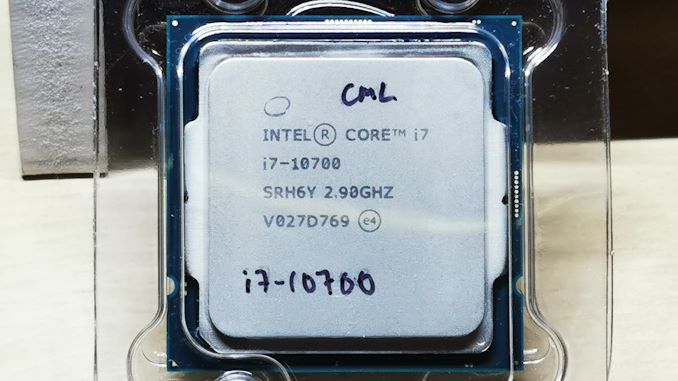Intel Core i7-10700 vs Core i7-10700K Review: Is 65W Comet Lake an Option?
by Dr. Ian Cutress on January 21, 2021 10:30 AM EST- Posted in
- CPUs
- Intel
- Core i7
- Z490
- 10th Gen Core
- Comet Lake
- i7-10700K
- i7-10700
Conclusion: TDP is Not Fit For Purpose
In years gone by, processors were sold with a single frequency and power rating. It was very quickly realized that if a processor could effectively go to sleep, using either lower voltage or lower frequency (or both) then a lot of idle power could be saved. Going the other way, processor designers realized that for temporary short bursts, a core could run at a higher frequency before it reached a thermal limit. Also, using a multi-core processor meant that either the power budget could be shared across all the cores, or it could be focused in one.
Both AMD and Intel have noticed this over time, and both companies have different attitudes on how they report numbers relating to ‘base frequency’ and related power as well as the bursty ‘turbo frequency’ and related power. Out of those four metrics, the only one Intel doesn’t provide is turbo power, because from their perspective it is system dependent.

Intel lets motherboard manufacturers determine how long a system can turbo for, and what that budget is. Intel encourages motherboard manufacturers to over-engineer the motherboards, not only for overclocking, but for non-overclockable CPUs to get the best performance for longer. This really messes up what the ‘default out-of-the-box performance’ should be if different motherboards give different values. The trend lately is that enthusiast motherboards enable an unlimited turbo budget, and the user building their system just has to deal with it.
This means that users who buy the Core i7-10700 in this review, despite the 65 W rating on the box, will have to cater for a system that will not only peak around 215 W, but sustain that 215 W during any extended high-performance load, such as rendering or compute. We really wished Intel put this 215 W value on the box to help end-users determine their cooling, as without sufficient guidance, users could be hitting thermal limits without even knowing why. At this point, 'Intel Recommended Values' for turbo time and budget mean nothing outside of Intel's own OEM partners building commercial systems.
Core i7-10700 vs Core i7-10700K Performance
In the review we highlighted that these two processors have a peak turbo frequency difference of 300 MHz and an all-core turbo frequency difference of 100 MHz. The fact that one is rated at 65 W and the other is rated at 125 W is inconsequential here, given that most end-user motherboards will simply enable turbo all the time. This means the performance in most of our tests between the two is practically identical, and consummate to a 100-300 MHz frequency difference.
In practically all of our tests, the Core i7-10700K is ahead by a super slim margin. At $387 for the 10700K compared to $335 for the 10700, the performance difference is not enough to warrant the $52 price difference between the two. Performance per dollar sides mostly with the Core i7-10700, although users getting the i7-10700K will likely look towards overclocking their processor to get the most out of it – that ultimately is what to pay for.
The other comparison point is with the Ryzen 5 5600X, which has two fewer cores but costs $299. In practically every test, the increased IPC of the Ryzen over Intel means that it sits identical with the Core i7 processors, AMD is cheaper on list price, and at a much lower power (AMD will peak around 76 W, compared to 215 W). AM4 motherboards are also abundant, while corresponding Intel motherboards are still expensive. The problem here however is that AMD is having such high demand for its product lines right now that finding one in stock might be difficult, and it probably won’t be at its recommended price.
Users in this price bracket have a tough choice – the more efficient AMD processor that might be in stock, compared to the Intel processor that will be in stock but more cooling will likely be required.











210 Comments
View All Comments
bji - Tuesday, January 26, 2021 - link
Then I would appreciate if the O.P. would indicate both what the MSRP is in his country as well as the price that he is quoting availability at so that all the details are known. Since he didn't say the MSRP was any different over there, I just assumed it was the same. It helps to seed the discussion with relevant information at the outset so that we don't have to devolve into useless bickering over unavailable data. I agree that I could have immediately asked what the MSRP was there instead of just assuming it, so that's on me, but even better would have been me not even having to ask.Qasar - Tuesday, January 26, 2021 - link
most of the time, MSRP, is based on US dollarsSpunjji - Wednesday, January 27, 2021 - link
It was safe to assume that, as his reply was in contradiction to yours, £279 was at or near MSRP.bji - Wednesday, January 27, 2021 - link
It is very difficult to get these parts at MSRP in the USA. I think the safer assumption is that it is also difficult to get these parts at MSRP elsewhere.And yet Anandtech will continue to show the USA MSRP in their CPU comparisons as if that is the realistically available price for the part, which is exactly the incorrect information I was trying to rail against when I posted my original comment that started this whole discussion.
Qasar - Thursday, January 28, 2021 - link
but its not incorrect information. the only reason hardware isnt anywhere near MSRP, is due to the fact, that there is more people wanting the hardware, then there are products available. not to mention, that MSRP is for all intents and purposes, constant vs what the prices are in stores.Spunjji - Friday, January 22, 2021 - link
UK RRP is £280. We have VAT and get the British Tax. 🙄Even at £300, I personally wouldn't lose sleep over a retailer taking an extra £20 given the crappy margins they usually get.
bji - Wednesday, January 27, 2021 - link
MSRP includes a mark-up for the retailer to already make the expected profit. A small additional profit is fine; but in the USA what you have is 'scalpers' buying up parts and then trying to resell them for egregious profits. Like a 33% mark-up is the minimum, and until recently 75% - 100% markups were the norm for the Ryzen 5 5600X.Spunjji - Thursday, January 28, 2021 - link
Yeah, I definitely wouldn't buy at those prices. Fortunately I'm in no hurry; the bank account lies empty. 😬drexnx - Thursday, January 21, 2021 - link
I also bought a 5800X at microcenter for MSRP in early December.The "bring up to counter to pick up" sheet they gave me showed they got 75 in on the shipment as well, so it wasn't like it was the one chip they got and I got lucky either...
bji - Thursday, January 21, 2021 - link
Oh my god how many times am I going to have to explain to posters on AnandTech that Micro Center is NOT general availability. They are limited to a few million people who happen to live within driving distance of one of their stores. I wish there was some way to put a disclaimer about Micro Center in my posts without just inviting further debate. I mean the WHOLE REASON that I wrote "general availability" in my comment and put the note about "hard to find vendor" was to try to head of the Micro Center comments, but, apparently, people who shop at Micro Center cannot fathom the idea that 95% of people in the USA do not have access to a Micro Center.